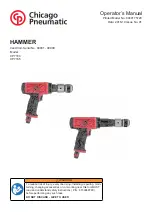
When cutting metal, it is recommended to apply a suitable cooling and
lubricating agent along the cutting line.
n
Contact protection
The contact protection (
1
) on the housing prevents unintentional
touching of the blade during work and is not to be removed.
n
Cutting
Use a drill to make a 10 mm hole in the cut area.
Insert the blade into the
opening and start cutting.
n
Plunge cutting
(see Fig.
C
-
D
)
NOTE:
The plunge cutting process can be used only on soft
materials, such as wood, plasterboards or similar!
Use only short blades for plunge cutting. Plunge cutting is
only possible with an angle of 0°.
Place the power tool with the front of the foot (
9
) on the workpiece and
switch it on. For power tools with stroke control, select the maximum
number of movements.
Press the power tool firmly against the workpiece and slowly introduce
the blade into the workpiece. The moment the foot (
9
) contacts the
workpiece with its entire surface, continue to cut along the desired line.
n
Cutting at an angle
(see Fig.
E
)
The jigsaw also allows cutting at an angle, in a range of 0° - 45°, both left
and right.
CAUTION
!
Before changing the angle of the jigsaw foot (
9
), disconnect the
battery from the device.
The jigsaw foot (
9
) is factory set in the middle position (0°). For cutting at
an angle, loosen the screw
s
(
16
) on the jigsaw foot plate (
9
) using a
screwdriver
. After slightly moving the foot back, it can be set at an angle,
in the above-mentioned range, using the scale (
17
). Once the foot is
adjusted, move the foot forward and tighten the screw
s
.
CAUTION
!
Check that the jigsaw foot is fixed securely. A moving, loose
foot can cause an accident during work.
After adjusting the foot, place the hex key in the socket next to the power
cord.
n
Auxiliary lighting
The jigsaw is equipped with auxiliary lighting (
2
) for the cutting point,
which is turned on when the switch (
4
) is pressed.
n
Tips
Basic principles of proper jigsaw use:
-
cut the material applying moderate pressure, do not allow excessive
load on the jigsaw;
-
excessive pressure on the jigsaw can cause the reciprocating motion to
be slowed down or interrupted, which slows down or stops the cutting
process;
-
during cutting the jigsaw foot should touch the workpiece along its
entire surface;
-
start cutting a shape in hard materials by pre-drilling of a hole that
allows the blade to be inserted. Otherwise, there is the risk of recoil and
the blade breaking;
-
when cutting lines that form a sharp angle or connected with a small
radius arc, use narrow blades, preferably, and turn off the auxiliary
pendulum action of the head
.
STORAGE AND MAINTENANCE:
The tool must be stored in a place that is not accessible to children and
must be kept clean and protected from moisture and dust. The storage
conditions should prevent potential mechanical damage and impact of
the weather conditions.
In principle, the jigsaw does not require any special maintenance or
service. However, periodic oiling of the blade guide roller will ensure its
longer durability.
Regularly check the condition of the screws securing the jigsaw housing
and foot. Tighten if necessary.
After work, it is recommended to blow over the ventilation holes and the
blade mount with compressed air. This will prevent damage to bearings,
remove dust blocking the supply of engine cooling air.
Clean the housing with a clean, damp cloth and a small amount of soap,
then wipe dry.
Do not use any cleaning agents or solvents; they can damage parts of the
device made of plastic.
Make sure that no water penetrates inside the device.
The charger may be cleaned exclusively with use of a dry cloth.
TRANSPORTATION:
Store and transport the tool in its transport box to protect it against
humidity, dust penetration and small objects; remember to protect its
ventilation openings. Small objects after getting into the casing can
result in damage to the motor.
If the battery is removed for transport or storage, make sure the contacts
will not short circuit. Remove metal items such as screws, nails, clasps,
loose bits, wires, or metal filings from the case or transport container or
otherwise prevent them from touching the battery.
MANUFACTURER:
PROFIX Co.Ltd.,
34
Marywilska Street,
03-228 Warsaw,
POLAND.
This appliance is in conformity with national and European standards as
well as with general safety guidelines.
NOTE:
In case of technical issues, contact an authorised technical service.
Any repairs are allowed to be carried out exclusively by qualified staff with
use of original spare parts.
PICTOGRAMS:
Explanation of the icons located on the nominal plate and the
information tags
:
9
«Never dispose of batteries in water.»
«Read this instruction before switching on the
power supply and starting the work.»
«Never dispose of batteries in fire.»
«Protect the battery against heat, e. g., against
continuous intense sunlight.»
«For indoor use only »
.










































